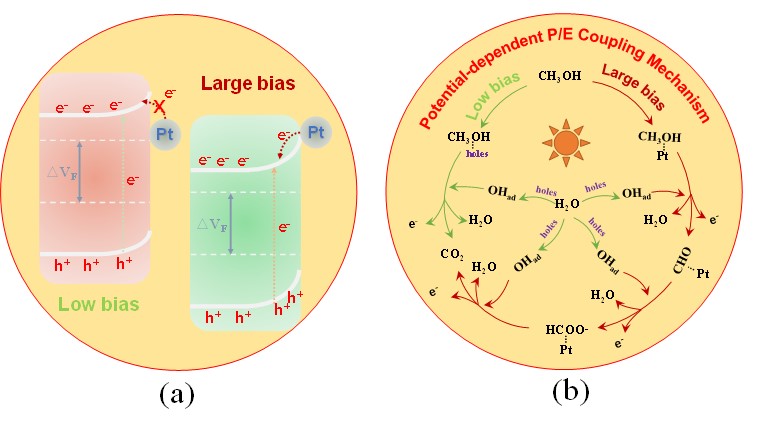Shixu Song, Yan Zhao, Qisen Jia, Wanqing Yu, Teng Fu, Fengfei Li, Jing Liu, Luhua Jiang*
Nanomaterials & Electrocatalysis Laboratory, College of Materials Science and Engineering, Qingdao University of Science and Technology, Qingdao 266042, P.R. China
Abstract: The sluggish methanol oxidation kinetics has seriously hindered the development of direct methanol fuel cells. Photo-electro-catalysis is expected to accelerate reaction rates, yet suffers from lack of efficient photoelectrocatalysts and more importantly, less understanding on photo-electro-catalysis mechanism. Herein, a unique Cu-Nb2O5 nanorod array with excellent light adsorption and charge transfer ability, on which supports Pt nanoparticles, is constructed for photo-electrocatalytic methanol oxidation reaction (MOR).Systematical investigation discovers a potential-dependent photo-electro-catalysis coupling mechanism, i.e., at lower potential bias where the Fermi level of semiconductor (Ef,s) is beyond the Fermi level of Pt (Ef,Pt), electrons transferring from Pt to semiconductor is switched off, so semiconductor Cu-Nb2O5 alone takes a dominant role for both methanol and water activation; at higher potential bias where Ef,s is below Ef,Pt, electrons flowing from Pt to semiconductor is switched on, so methanol dehydrogenation on Pt surface is allowed energetically. Further investigation on the MOR processes prompts us to propose a MOR pathway that methanol dehydrogenates on Pt surface, with the aid of *OH from the photo-activated water on Cu-Nb2O5 to proceed via formaldehyde, formic acid to carbon dioxide, resulting to a low apparent activation energy and fast kinetics of MOR as compared to its counterpart Pt/Nb2O5. This work not only provides an efficient photoelectrocatalyst for methanol oxidation, but also sheds lights on the underlying photo-electro-catalysis coupling mechanism over semiconductor-metal catalysts.
Keywords: Methanol oxidation; photo-electrocatalysis; coupling mechanism; Nb2O5 nanorod array; band structure.
* Corresponding author: luhuajiang@qust.edu.cn (L. Jiang)
https://doi.org/10.1016/j.cej.2024.152550



